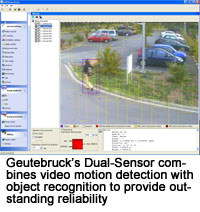As integration brings video and alarms together, video verification overcomes the weaknesses of each system alone. When properly done, it relieves human operators from physically verifying whether every alarm was a real intrusion.
As integration brings video and alarms together, video verification overcomes the weaknesses of each system alone. When properly done, it relieves human operators from physically verifying whether every alarm was a real intrusion.
With video and alarm integration more and more prevalent in security, A&S is going to look at its smart and popular techniques and applications more thoroughly.
Integration
Combining several systems suits remote monitoring needs, such as power line transmission sending alarm and video over the same cables. Some alarm cables now support video, saving cabling costs significantly.
Other solutions have video built right into some alarm systems. "In Av-Gad alarm panels, a dedicated output is activating the video camera, so the user or installer can program this feature to activate automatically or manually," Keren said. "The user or central station can remotely activate the video verification by simple command from mobile or office phone. The command is done by DTMF dial with password protection, a unique feature that does not exist in other panels."
Alarm support can be seen in video servers as well, demonstrating that integration is alive and well. "The VVR (Video Alarm Verification Reporter) is an IP video server specially designed for the security market to be integrated with intruder control panels," Engelsman said. "The VVR helps verify and distinguish between a real alarm situation and a false one by sending a real-time video clip of the event via MMS messages to a FTP server and then onward to a CMS or user's mobile phone."
Also on the product level are PIR cameras, combining a PIR detector with a camera. "The portable battery powered P-cam (PIR motion sensor with integrated camera and illuminators) can be installed anywhere, often mounted on portable stands that can be picked up and moved around as the situation demands — no trenching, no wires," Ferre said. "The integrated PIR motion sensor detects intruders in storms and blizzards, ignoring the rain or snow."
 Other vendors integrate video and alarms at the management software level. "Visonic offers a fully integrated broadband based surveillance and control solution," said Oren Kotlicki, Head of Product Management, Visonic. "The solution is targeted at mass market service providers wishing to offer video alarm verification solution with the ability to grow to a full-grade Web-based remote control, surveillance and messaging service offered to end users."
Other vendors integrate video and alarms at the management software level. "Visonic offers a fully integrated broadband based surveillance and control solution," said Oren Kotlicki, Head of Product Management, Visonic. "The solution is targeted at mass market service providers wishing to offer video alarm verification solution with the ability to grow to a full-grade Web-based remote control, surveillance and messaging service offered to end users."
Video Verification
Integration is intended to give human operators a better idea of what's going on, with video verification presenting information in a timely fashion. Thus, real-time alerts for operators are vital.
Systems can be configured for cameras to start rolling when alarms or other devices are triggered. "If the access system or alarm sensor detects unwanted activity, the video recorder can be programmed to increase the recorded pictures per second," D'Aries said. "In addition, security guards, managers, administrators, business owners and even law enforcement can be notified upon an alarm. They immediately know the location and nature of the alarm so they can remedy the problem immediately."
 This text information on alarm location gives users a better idea of how serious the alarm is, such as one at a highly restricted area. "They don't need to waste time by first checking the video system for such details," D'Aries said. "Without having to physically verify what is happening on their surveillance system, they can immediately respond to the alarm and take action."
This text information on alarm location gives users a better idea of how serious the alarm is, such as one at a highly restricted area. "They don't need to waste time by first checking the video system for such details," D'Aries said. "Without having to physically verify what is happening on their surveillance system, they can immediately respond to the alarm and take action."
Law enforcement can use real-time images to respond appropriately. "Police treat video verified alarms as a 'crime in progress' and respond faster than for a routine alarm," Ferre said. "Video verification makes law enforcement more efficient and provides greater security to the property owner."
The networked response has advantages over analog video, which is more for forensic purposes rather than real-time alerts. "In contrast, property owners use traditional CCTV systems and DVRs to review what happened after an incident occurs and identify the intruder," Ferre said. "More often than not, identification is impossible because of poor lighting and intruders wearing masks or hoods."
Reducing False Alarms
Several solutions are deployed to keep false alarms down. As it can be costly to respond to every triggered alarm, smarter detection is a boon for integrated video and alarm solutions.
 Integration with mobile devices can determine whether an event is an actual or false alarm. "The VVR helps reduce false alarms by capturing real-time alarm situations and transmitting them directly to the end user's mobile phone in a video clip MMS format," Engelsman said. "This allows the end user to view the alarm scene immediately and evaluate the situation — whether it is a real alarm situation or a false one created by an animal passing by or a window broken from a windy weather.'
Integration with mobile devices can determine whether an event is an actual or false alarm. "The VVR helps reduce false alarms by capturing real-time alarm situations and transmitting them directly to the end user's mobile phone in a video clip MMS format," Engelsman said. "This allows the end user to view the alarm scene immediately and evaluate the situation — whether it is a real alarm situation or a false one created by an animal passing by or a window broken from a windy weather.'
Remotely verifying alarms by video will provide operators with more information and may not necessarily reduce false alarms. "Video verification does not reduce false alarms but provides the central station with the ability to recognize that the alarm is false," Kotlicki said. "The combination of PIR detectors with a camera compared to a video motion detection (VMD) based camera as a stand-alone solution provides dramatic reduction in false alarms as alarms are triggered by PIR detectors."
A P-cam can be an affordable way to reduce false alarms. "The PIR detector and camera solution is in many times more cost-effective, as high-end VMD cameras are quite expensive, while low-end VMD cameras are not reliable in terms of video motion detection and can provide lots of false alarms," Kotlicki said.
 Other solutions focus on fine-tuning the alarms themselves, ensuring they are not triggered for non-events. "Suren's DFIR (dual-frequency infrared) technology inherently rejects all non-moving temperature-changing objects and limited-motion objects — the biggest sources of false alarms," Micko said. "Of course, video verification can help, but that requires an operator's time. Suren's thinking is to avoid alerting the operator unless there is actually a person moving in the sensor's monitored area."
Other solutions focus on fine-tuning the alarms themselves, ensuring they are not triggered for non-events. "Suren's DFIR (dual-frequency infrared) technology inherently rejects all non-moving temperature-changing objects and limited-motion objects — the biggest sources of false alarms," Micko said. "Of course, video verification can help, but that requires an operator's time. Suren's thinking is to avoid alerting the operator unless there is actually a person moving in the sensor's monitored area."
If users already have cameras and can support analytics, they can set rules to minimize false alarms, such as rain or snow. "To help ensure alarms are only triggered for real events, features such as camera calibration and perspective correction greatly enhance intelligent video analysis accuracy and reliability," Otterspeer said. "Also, special filters for size, speed, direction and aspect ratio minimize false alarm rates."
Cost-Saving Features
The goal of video and alarm integration is to save human operating expenses, which translates into a range of functions.
Some are designed for the alarms themselves to be more discriminating. "Suren's solution will provide maximum false-alarm rejection, including animals, so as to reduce costs of operators responding to false alarms," Micko said. "Suren's wireless solutions also will help to reduce installation costs."
Networked solutions also incur fewer costs. "Pima's VVR offers an alternative low- cost solution for video verification by using the Internet instead of paying the high costs of cellular MMS charges," Engelsman said. The remote video solution "saves time, traveling and loss of property."
cost solution for video verification by using the Internet instead of paying the high costs of cellular MMS charges," Engelsman said. The remote video solution "saves time, traveling and loss of property."
Considering the amounts of data required for video alarm verification, Internet transmission drives the overall cost lower. "The solution empowers the broadband connectivity channel," Kotlicki said. "While PSTN communications and GPRS are charged by communication or by the amount of data sent, which get quite expensive when video has to be sent, broadband communication has a fixed price to it."
Too many false alarms can result in fees. "In many countries, the police or the central station charges the end user a fine in case that the alarm is a false alarm," Kotlicki said. The Visonic solution also cuts energy costs, by integrating with home automation devices to switch them off when left on, such as lights or air conditioners.
Challenge
Integration of video and alarms requires vendors to come up with more products and solutions to satisfy perfect convergence. This claim will exert vendors to do more homework so that interoperability standards could work out properly and ideally.
As D'Aries has understated, "we are prepared to meet the challenges. The hardware and software is available, and the market is asking for solutions that could lead to interoperability standards."